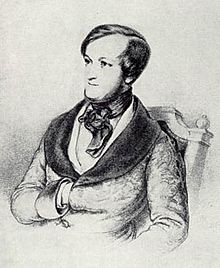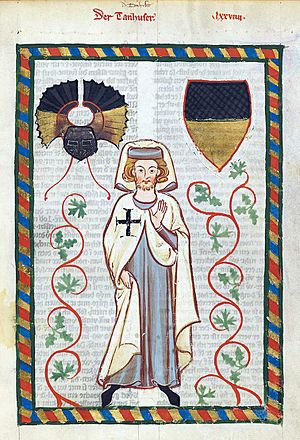Tannhäuser facts for kids
Quick facts for kids Tannhäuser |
|
|---|---|
| by Richard Wagner | |

Wagner, ca. 1840
|
|
| Genre | Opera in 3 acts |
| Native title | Tannhäuser und der Sängerkrieg auf Wartburg |
| Translation | Tannhäuser and the Singers' Contest at Wartburg |
| Librettist | Richard Wagner |
| Language | German |
| Premiere | Dresden Royal Opera, Dresden, Germany 15 October 1845 |
Tannhäuser und der Sängerkrieg auf Wartburg (which means Tannhäuser and the Singers' Contest at Wartburg) is a famous opera. It has three acts and was created by Richard Wagner. He wrote both the music and the story. This was Wagner's fifth opera. He worked on it from 1842 to 1845.
The opera first opened on October 19, 1845. It was performed at the Dresden Royal Opera in Germany. Wagner himself conducted the show. Tannhäuser was a big hit and became very popular in Germany. In 1859, it was the first Wagner opera performed in the United States.
Wagner tried to change the opera for the Paris Opera in 1861. But things did not go well. There were protests against him. He had to take the opera out of Paris. It was not shown in France again until 1895. However, Tannhäuser opened the second season of the Metropolitan Opera in New York City in 1884.
Contents
How Tannhäuser Was Created
Richard Wagner was finishing another opera in Paris. It was called The Flying Dutchman. During this time, he started thinking about a new opera. A friend suggested the story of Tannhäuser. At first, Wagner did not like the idea.
But when he returned to Germany, he read more about Tannhäuser. He found stories by writers like Tieck and Heine. While on vacation, he changed his mind. He began to plan out the opera Tannhäuser. Back in Dresden, he worked hard on the story. He finished the opera in October 1845. He led the first performance himself.
The first performances were a bit confusing for the audience. Wagner's singers also found the music hard. He started making changes right away. Later, in 1859, Wagner offered Tannhäuser to the Paris Opéra. They wanted the opera sung in French. They also wanted a ballet in the second act. This was so a group called the Jockey Club could arrive after dinner to watch the dancers.
Wagner did not want to move the ballet. This caused problems. Members of the Jockey Club interrupted the show. The Paris performances were a disaster. The opera was not performed in France for 34 years after that. Wagner later made more changes to the Paris version. He made it sound even better than his first try.
Main Characters
- Tannhäuser, a knight and Minnesinger (a medieval German singer) - tenor
- Venus, a goddess - soprano
- Elisabeth, a princess and niece of the Landgrave - soprano
- Hermann, the Landgrave of Thuringia (a ruler) - bass
- Wolfram von Eschenbach, a knight and Minnesinger - baritone
- Walther von der Vogelweide, a knight and Minnesinger - tenor
- Biterolf, a knight and Minnesinger - bass
- Heinrich der Schreiber, a knight and Minnesinger - tenor
- Reinmar von Zweter, a knight and Minnesinger - bass
- Young shepherd - soprano
- Four noble pages - trebles
What Happens in the Opera
The story of Tannhäuser is about choosing between two kinds of love. It explores spiritual love and worldly love. It also talks about finding forgiveness through love. The story is based on an old German legend about a real person named Tannhäuser. It also includes the myth of Venus, the goddess of love. The opera also features medieval Minnesingers.
Part of the opera takes place in a magical, mythical world. This is the Venusberg, where Venus lives. The other part takes place in a historical setting, the Wartburg castle.
- Act 1. Long ago, the old gods and goddesses were scattered. Venus now lives in a magical mountain called Venusberg in Germany. Tannhäuser, a Minnesinger, has been living with her. He has enjoyed his time there, but he is now tired of this life. He wants to return to the human world. Venus lets him go. But she warns him that he will come back to her one day.
Tannhäuser finds himself in a valley near Wartburg castle. This is where his old love, Elisabeth, lives. He is praying when the Landgrave and his knights find him. They welcome him back. Tannhäuser returns to the castle with them.
- Act 2. Elisabeth is very happy. She enters the castle's Hall of Song. She is thrilled that Tannhäuser has returned. She promises her love to him again. Wolfram, Tannhäuser's friend, watches sadly. He also loves Elisabeth.
The Landgrave announces a song contest. Many guests fill the Hall. The singers must sing about the true meaning of love. The other singers sing about pure and spiritual love. But Tannhäuser sings about worldly, human love. The guests are shocked by his words. Elisabeth defends Tannhäuser. The Landgrave tells Tannhäuser to go to Rome. He must ask the Pope for forgiveness. Tannhäuser joins a group of pilgrims and leaves.
- Act 3. Months pass by. Tannhäuser has not returned with the pilgrims. Elisabeth is heartbroken. Wolfram sings a sad song to the evening star. Wolfram later finds Tannhäuser on a path near the castle. Tannhäuser tells him that the Pope did not forgive him. This is because of his time with Venus. Tannhäuser feels hopeless.
Venus appears in a vision. She tells Tannhäuser to come back to her. But Wolfram whispers Elisabeth's name. The vision of Venus disappears. A procession appears, carrying the dead Elisabeth. Tannhäuser falls onto her body and dies. Pilgrims arrive, announcing a miracle. The Pope's wooden staff has suddenly bloomed with flowers. This means Tannhäuser has been forgiven.
Early Performances
The first performance of Tannhäuser outside of Dresden was in Weimar. This showed that smaller theaters could also put on the opera. Other early shows happened in places like Schwerin, Prague, and New York. In London, the opera was performed in Italian in 1876.
In Vienna, Johann Strauss II performed parts of the opera in 1853. The first full performance in Austria was in Graz in 1854. Vienna staged the opera in 1857. The Vienna court opera performed it in 1875. In 1860, the Paris Opera wanted a changed version of the work in French. Wagner made many changes for Paris.
Popular Songs and Scenes
Some parts of Tannhäuser became very popular early on:
- Tannhäuser's song praising Venus
- The Pilgrims' Chorus
- Wolfram's plea to Tannhäuser to return to the Minnesingers
- The Entrance of the Guests
- Wolfram's song to the Evening Star
Images for kids
See also
 In Spanish: Tannhäuser para niños
In Spanish: Tannhäuser para niños




